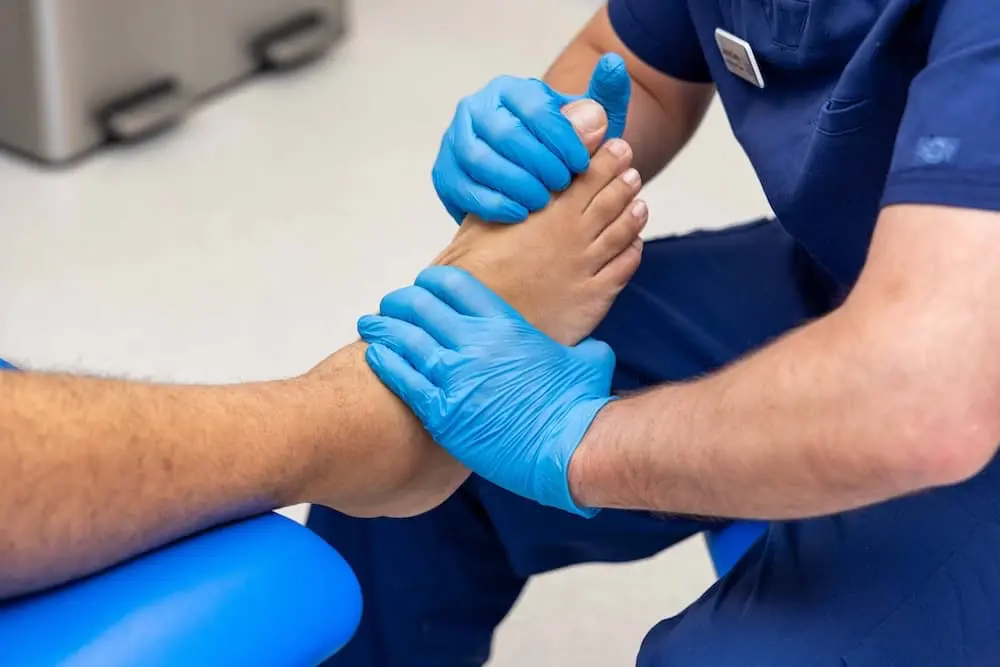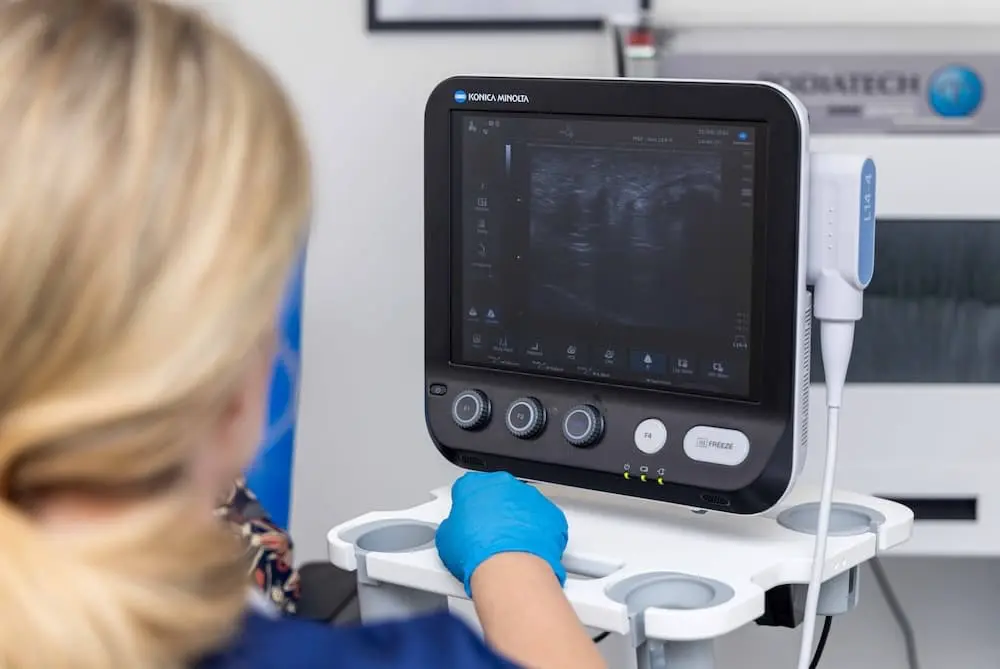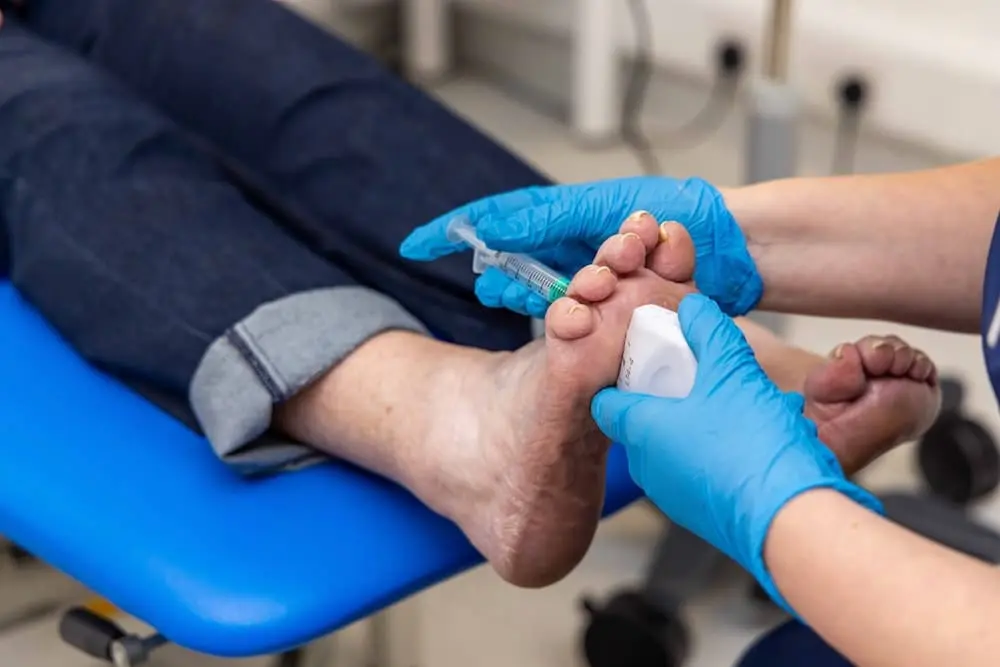MORTON’S NEUROMA
Don’t let every step be a pain in the foot! Morton’s neuroma might be small, but its impact can be huge. Discover how our expert podiatrists can help you stride confidently again. Take the first step towards pain-free walking today!

Services
WHAT IS MORTON’S NERUOMA?
Morton’s neuroma is a common foot condition that affects the nerves between the third and fourth toes. Neuroma’s can present between other toes, but these are not known as a Morton’s Neuroma. A neuroma is thickening of the tissue around one of the nerves leading to your toes.
This condition occurs when the nerve, usually the common plantar digital nerve, becomes thickened and inflamed, often due to repetitive stress or pressure. The affected nerve enlarges and can become trapped between the metatarsal bones, leading to pain and discomfort. While small in size (typically 5-10 mm), Morton’s neuroma can cause significant discomfort and may worsen if left untreated.
It affects approximately one in three people at some point in their lives, with middle-aged women being the most commonly affected group. Understanding its nature as a nerve condition is crucial for determining appropriate treatment approaches.
WHAT CAUSES MORTON’S NEUROMA?
Morton’s neuroma develops due to a combination of factors that irritate or compress the nerve between the toes. The primary causes include:
Footwear Choices: Tight shoes that squeeze the toes together. High-heeled shoes that increase pressure on the forefoot. Shoes with narrow toe boxes.
Foot Structure and Mechanics: Flat feet or high arches. Bunions or hammertoes that alter foot mechanics. Hypermobile feet (excessive movement in the foot joints).
Repetitive Stress: High-impact sports (e.g., running, tennis, basketball). Activities involving prolonged standing or walking.
Trauma: Direct injury to the foot. Sudden or forceful impact on the ball of the foot.
Obesity: Excess weight increases pressure on the feet.
Often, Morton’s neuroma results from a combination of these factors, making a professional assessment crucial for identifying the specific causes and developing an effective treatment plan. At MyFootMedic we can perform a thorough assessment and utilise ultrasound imaging if necessary to assist in your diagnosis.


HOW CAN MORTON’S NEUROMA BE TREATED?
At MyFootMedic, we offer a comprehensive range of treatments for Morton’s neuroma, tailored to each patient’s specific needs. The first step is to make an accurate diagnosis, this can be performed through physical assessments as well as ultrasound imaging at our clinic. Our treatment options include:
Conservative Treatments
Footwear Advice: The wrong footwear choices play a large role in neuroma formation and treatment. Our Podiatrists can help advise you on the correct footwear features to help with your symptoms.
Insoles and Orthotics: We offer custom and prefabricated insoles and orthotics, these are personalised shoe inserts designed to redistribute pressure away from the neuroma and to address biomechanical abnormalities. Metatarsal pads may be used to spread the metatarsal bones and reduce nerve compression.
Activity Modifications: Advising on alternative low-impact activities to reduce stress on the foot. Recommending proper warm-up and cool-down routines for athletes.
Physical Therapy: Prescribing specific stretching exercises to improve foot flexibility. Teaching strengthening exercises for better foot muscle support. Manipulation of joint and soft tissue to improve joint range and quality of motion, reducing nerve compression.
Advanced Non-Surgical Treatments
Corticosteroid Injections: Administering ultrasound guided steroid injections to reduce inflammation and thickening of nerve tissue, whilst providing pain relief.
Surgical Interventions
Decompression Surgery: Performing minimally invasive surgery to release pressure on the nerve
Neurectomy: Surgically removing the affected portion of the nerve. Recommending this option when conservative treatments have failed.
*We do not offer surgical procedures for Morton’s Neuroma, but we work closely with local surgeons and can refer when appropriate.
Our experienced podiatrists work closely with each patient to develop a personalised treatment plan. We emphasise the importance of early intervention for better outcomes.
LET’S ANSWER YOUR MORTON’S NEUROMA QUESTIONS!
Several factors can worsen the symptoms of Morton’s neuroma, making it important to be aware of these aggravating elements. Tight, narrow shoes, especially those with high heels or pointed toes, are major culprits as they compress the toes and put extra pressure on the ball of the foot. Activities that involve repetitive impact on the forefoot, such as running or court sports, can exacerbate the condition.
Prolonged standing or walking, particularly on hard surfaces, may also increase discomfort. Certain foot deformities like bunions, hammertoes, or high arches or flat feet can contribute to neuroma irritation by altering foot mechanics. Weight gain adds extra stress to the feet, potentially aggravating the neuroma. Additionally, wearing shoes without supportive features or cushioning can lead to increased nerve compression.
By understanding these aggravating factors, patients can make lifestyle and footwear choices that help manage their symptoms and prevent the condition from worsening. If you’re experiencing increased pain or discomfort, we recommend scheduling an appointment for a thorough evaluation and personalised advice.
Walking with Morton’s neuroma is generally safe and can even be beneficial, but it’s important to approach it carefully. Moderate, low-impact walking can help maintain foot flexibility and strength, which are crucial for overall foot health. However, the key is to walk comfortably and pain-free. If walking causes significant pain, it’s best to limit your activity until you’ve consulted with a Podiatrist.
When you do walk, wear shoes with a wide toe box, good support, and cushioning to reduce pressure on the affected area. Avoid high heels and tight shoes that compress your toes. Consider using prescription orthotics or metatarsal pads to redistribute pressure away from the neuroma and reduce compression on the nerve. Start with short walks and gradually increase duration as tolerated. If pain persists or worsens, it’s crucial to rest and seek professional advice.
At our clinic, we can assess your specific condition and provide personalised recommendations on how to stay active while managing your Morton’s neuroma effectively. Remember, early intervention and proper management can help prevent the condition from worsening and maintain your mobility.
Ignoring Morton’s neuroma can lead to a progression of symptoms and potentially serious complications. Initially, the pain and discomfort may be intermittent, but without proper treatment, these sensations can become more frequent and intense. Persistent pressure on the affected nerve can cause it to thicken further, exacerbating the condition and making it more challenging to treat.
Over time, you may experience constant pain, even when not wearing shoes, which can significantly impact your daily activities and quality of life. Chronic pain may lead to altered walking patterns as you try to avoid putting pressure on the painful area, potentially causing secondary issues in your feet, ankles, knees, hips, or back. In severe cases, permanent nerve damage can occur, resulting in chronic numbness or altered sensation in the affected toes. Additionally, the ongoing discomfort may lead to reduced physical activity, which can have broader health implications. While Morton’s neuroma rarely leads to dangerous medical emergencies, ignoring it can result in a condition that’s more difficult to treat, potentially requiring more invasive interventions like surgery.
Morton’s neuroma rarely goes away completely on its own without any intervention. While the pain associated with Morton’s neuroma may occasionally subside temporarily, especially if you avoid aggravating factors, the underlying condition typically persists. The thickened nerve tissue that characterises Morton’s neuroma doesn’t spontaneously resolve. However, in some mild cases, symptoms may improve if you make immediate changes to footwear and activity levels.
Wearing shoes with a wider toe box, lower heels, and good support can help alleviate pressure on the affected area. Resting the foot and avoiding high-impact activities may also provide temporary relief. Despite these self-care measures, most cases of Morton’s neuroma require professional treatment for long-term improvement. Without proper management, symptoms often worsen over time, making the condition more difficult to treat.
Early diagnosis and treatment significantly increase the chances of treating the condition effectively and preventing its progression.
Several foot conditions can present symptoms similar to Morton’s neuroma, making accurate diagnosis crucial. Stress fractures of the metatarsal bones may also cause localised pain in a similar area. Capsulitis, an inflammation of the ligaments surrounding the toe joints, can produce comparable discomfort. Intermetatarsal bursitis, where small fluid-filled sacs between the metatarsal heads become inflamed, may cause pain that resembles Morton’s neuroma. Plantar plate tears, which affect the ligaments under the toe joints, can also cause pain in the ball of the foot. In some cases, arthritis in the metatarsophalangeal joints or referred pain from lower back issues might be mistaken for Morton’s neuroma.
Given these similarities, self-diagnosis can be challenging and potentially misleading. At our clinic, we use advanced diagnostic techniques, including physical examination, ultrasound imaging, and our extensive experience to differentiate Morton’s neuroma from other conditions. This precise diagnosis is crucial for developing an effective treatment plan tailored to your specific condition.
MORTON'S NEUROMA TREATMENT IN BEDFORD WITH MYFOOTMEDIC
Take Control of Your Foot Health. Morton’s Neuroma can significantly impact your daily life, but with MyFootMedic in Bedford, effective treatment is within reach. Don’t let Morton’s Neuroma hold you back from enjoying life to the fullest. Our experienced podiatry team at MyFootMedic are ready to guide you through your treatment journey.
Book an appointment today and let’s work together to get you back on your feet comfortably.




